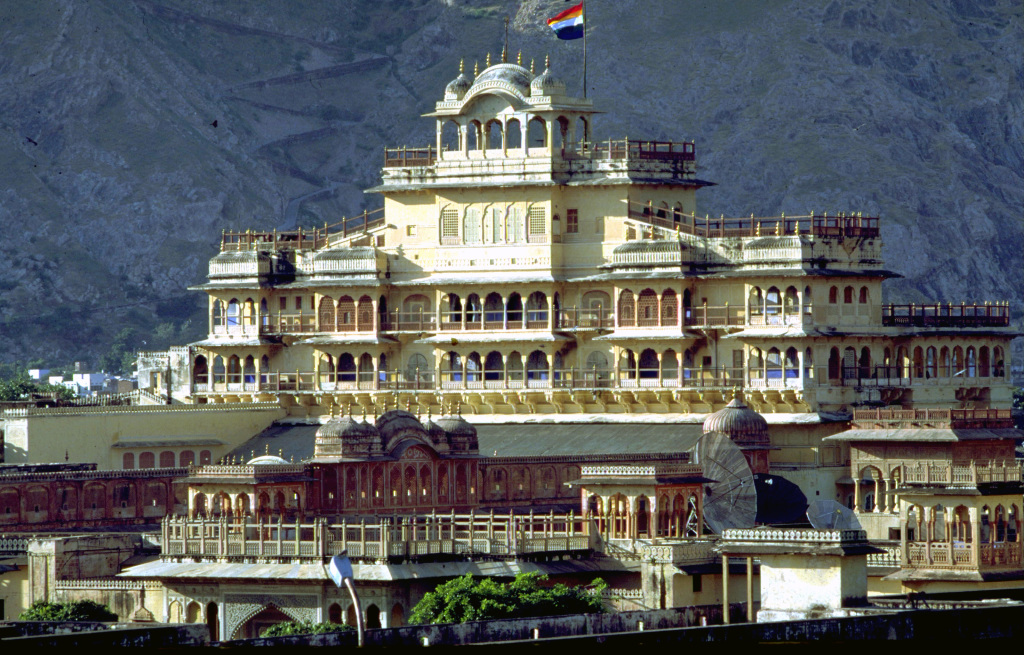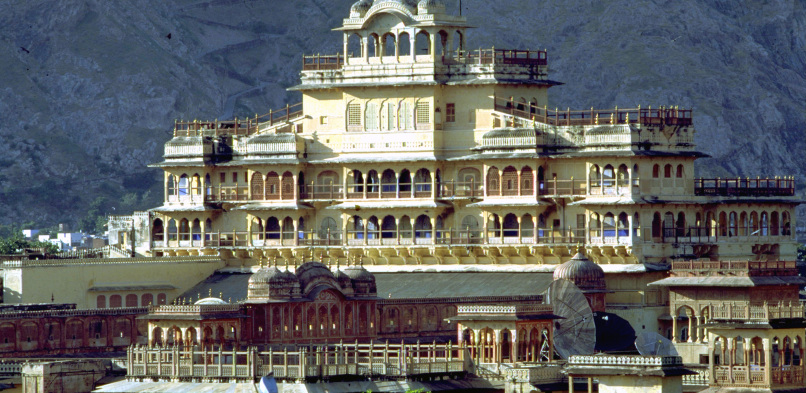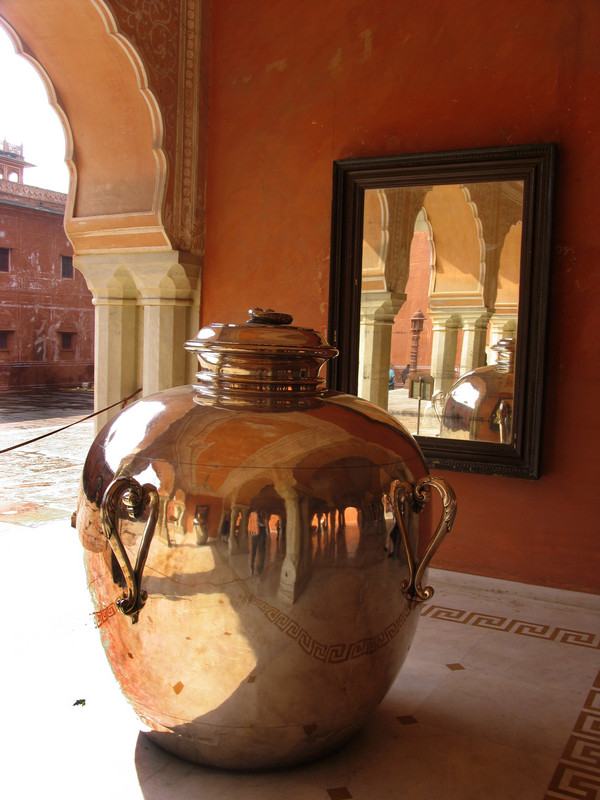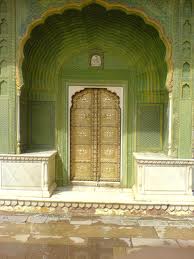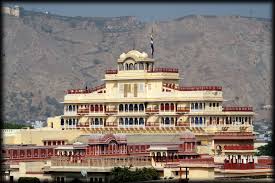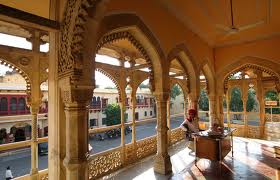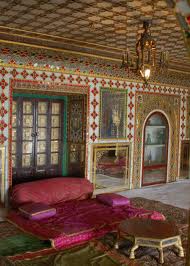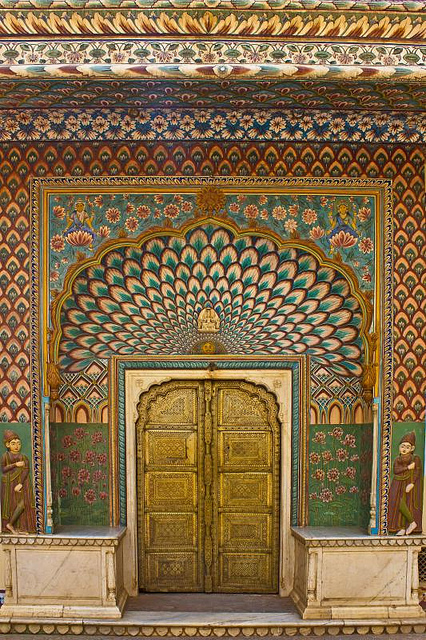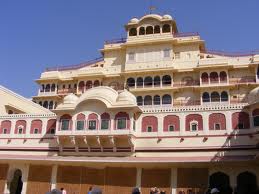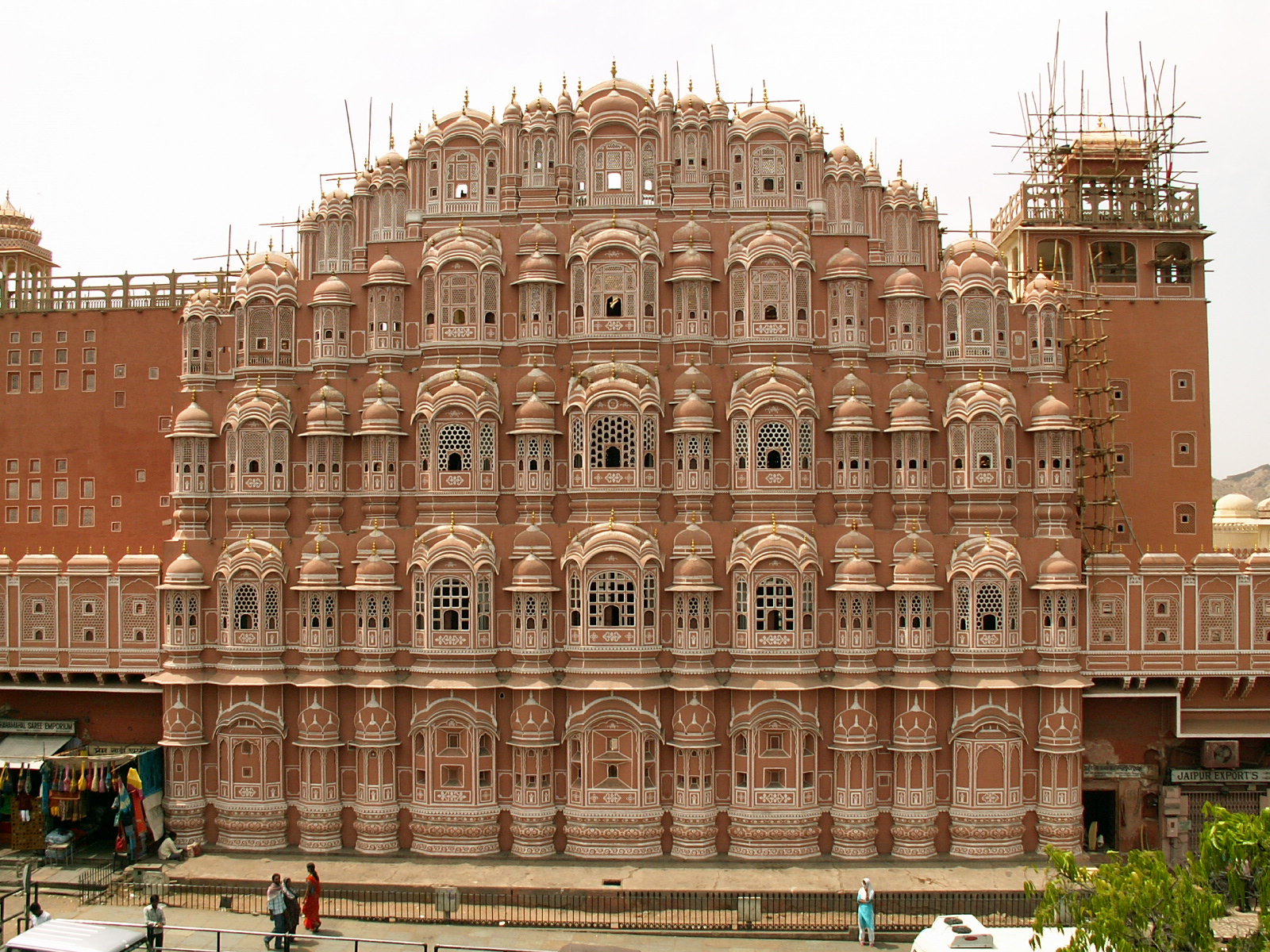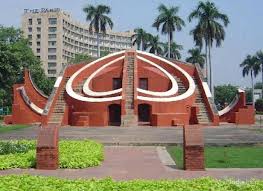India /Rajasthan /Jaipur /Jaipur
Sight Address : City Palace is near Chokri Shahad, Old City, Jaipur. Edit
Detail InformationEdit
City Palace is in the central-northeast part of the Jaipur city, which is laid in a grid pattern with wide avenues. It is a unique and arresting complex of several palaces, pavilions, gardens and temples. The most prominent and most visited structures in the complex are the Chandra Mahal, Mubarak Mahal, Mukut Mahal, Maharani’s Palace, Shri Govind Dev Temple and the City Palace Museum. Entrance gates, Mubarak Mahal, Chandra Mahal, Pitam Niwas Chowk, Diwan-I-Khas, Diwan-I-Aam, Maharani palace, Bhaggi Khana, Govind Dev Ji temple.
Chandra Mahal : Chandra Mahal or Chandra Niwas is the most commanding building in the City Palace complex, on its west end. It is a seven-storeyed building and each floor has been given a specific name such as the Sukh-Niwas, Ranga-Mandir, Pitam-Niwas, Chabi-Niwas, Shri-Niwas and Mukut-Mandir or Mukut Mahal. It contains many unique paintings, mirror work on walls and floral decorations. At present, most of this palace is the residence of the descendants of the former rulers of Jaipur. Only the ground floor is allowed for visitors where a museum is located that displays carpets, manuscripts and other items that belonged to the royal family. There is beautiful peacock gate at the entry to the Mahal. It has screened balconies and a pavilion at the roof from where a panoramic view of the city can been seen. It is set amidst well laid out gardens and a decorative lake in the foreground.
Mubarak Mahal : Mubarak Mahal, meaning the ‘Auspicious Palace’, was built with a fusion of the Islamic, Rajput and European architectural styles in the late 19th century by Maharaja Madho Singh II as reception centre. It is a museum; a fine repository of variety of textiles such as the royal formal costumes, sanganeri block prints, embroidered shawls, Kashmiri Pashminas and silk saris as part of the Maharaja Sawai Man Singh II Museum. A noteworthy display here is of the set of voluminous clothes worn by Sawai Madhosingh I, who was 1.2 metres (3.9 ft) wide and weighed 250 kilograms (550 lb) but interestingly had 108 wives.
Pitam Niwas Chowk : It is the inner courtyard, which provides access to the Chandra Mahal. Here, there are four small gates (known as Ridhi Sidhi Pol) that are adorned with themes representing the four seasons and Hindu gods. The gates are the Northeast Peacock Gate (with motifs of peacocks on the doorway) representing autumn and dedicated Lord Vishnu; the Southwest Lotus Gate (with continual flower and petal pattern) suggestive of summer season and dedicated to Lord Shiva-Parvati; the Northwest Green Gate, also called the Leheriya (meaning: “waves”) gate, in green colour suggestive of spring and dedicated to Lord Ganesha, and lastly, the Rose Gate with repeated flower pattern representing winter season and dedicated to Goddess Devi.
Diwan-I-Khas : Diwan-I-Khas was a private audience hall of the Maharajas, a marble floored chamber. It is located between the armoury and the art gallery. There are two huge sterling silver vessels of 1.6 metres (5.2 ft) height and each with capacity of 4000 litres and weighing 340 kilograms (750 lb), on display here. They were made from 14000 melted silver coins without soldering. They are officially recorded by the Guinness Book of World Records as the world’s largest sterling silver vessels.[14] These vessels were specially made by Maharaja Sawai Madho Singh II, who was a highly pious Hindu, to carry the water of the Ganges to drink on his trip to England in 1901 (for Edward VII’s coronation) as he was finicky about committing religious sin by consuming the English water. Hence, the vessels are named as Gangajelies (Ganges-water urns). There are a number of crystal chandeliers hanging from the ceiling (normally covered with plastic sheets to prevent dust collection), which are uncovered on special occasions.
Diwan-I-Aam : The ‘Diwan-E-Aam’ (Sabha Niwas) or the ‘Hall of Public Audience’ is an enchanting chamber, with the ceiling painted in rich red and gold colours, which still looks vibrant. It is a major Arrraction in the Mubarak Mahal courtyard. This chamber, functioning now as an art gallery, has exhibits of exquisite miniature paintings (of Rajastahni, Mughal and Persian art), ancient texts, embroidered rugs, Kashmir shawls and carpets. The ceiling is richly decorated. At present, it is an art gallery showcasing enthralling painted ceilings and rare ancient handwritten original manuscripts of Hindu scriptures (the Hindu holy scripture of the Bhagavad Gita handwritten in tiny script). Also seen in the art gallery is the Golden throne (called as Takth-e-Rawal) that was the seat of the Maharaja during public audience. It was mounted on an elephant or carried by palanquin bearers during the Maharajas visit outside the palace. At the entry gateway to the hall, two large elephants, each made out of single marble rock are on display.
Maharani Palace : Maharani’s Palace was originally the residence of the royal queens. It has been converted into a museum, where weapons used by the royalty during war campaigns are displayed, including those belonging to the 15th century. The ceiling of this chamber has unique frescoes, which are preserved using jewel dust of semiprecious stones. A particular weaponry on display is the scissor-action dagger, which when thrust into an enemy’s body is said to disembowel the victim, on its withdrawal.
Bhaggi Khana : Bhaggi Khana is a museum in the palace complex where a collection of old carriages, palanquins and European cabs adopted as Baggis to Indian situations are on display here. The Baggi which attracts attention is the one gifted by Prince of Wales to the Maharaja in 1876, called the Victoria Baggi. Also on display here are the Mahadol, a palanquin with a single bamboo bar that was used to carry the priests and a Ratha (chariot) that was used for carrying the idols of Hindu Gods in procession on festive occasions.
Govind Dev Ji temple : Govind Dev Ji temple, dedicated to the Hindu god Lord Krishna, is part of the City Palace complex. It was built in early 18th century outside the walls set in a garden environment. It has European chandeliers and paintings of Indian art. The ceiling in the temple is ornamented in gold. Its location provided a direct view to the Maharaja from his Chandar Mahal palace. The arathi (prayer offering) for the deity can be seen by devotees only for seven times during the day.
HistoryEdit
City Palace complex lies in the heart of Jaipur city, to the north-east of the very centre, located at 26.9255°N 75.8236°E. The site for the palace was located on the site of a royal hunting lodge on a plain land encircled by a rocky hill range, five miles south of Amber (city). The history of the city palace is closely linked with the history of Jaipur city and its rulers, starting with Maharaja Sawai Jai Singh II who ruled from 1699-1744. He is credited with initiating construction of the city complex by building the outer wall of the complex spreading over many acres. Initially, he ruled from his capital at Amber, which lies at a distance of 11 kilometres (6.8 mi) from Jaipur. He shifted his capital from Amber to Jaipur in 1727 because of an increase in population and increasing water shortage. He planned Jaipur city in six blocks separated by broad avenues, on the classical basis of principals of Vastushastra and other similar classical treatise under the architectural guidance of Vidyadar Bhattacharya, a man who was initially an accounts-clerk in the Amber treasury and later promoted to the office of Chief Architect by the King. Following Jaisingh’s death in 1744, there were internecine wars among the Rajput kings of the region but cordial relations were maintained with the British Raj. Maharaja Ram Singh sided with the British in the Sepoy Mutiny or Uprising of 1857 and established himself with the Imperial rulers. It is to his credit that the city of Jaipur including all of its monuments (including the City Palace) are stucco painted ‘Pink’ and since then the city has been called the “Pink City”. The change in colour scheme was as an honour of hospitality extended to the Prince of Wales (who later became King Edward VII) on his visit. This colour scheme has since then become a trademark of the Jaipur city. Man Singh II, the adopted son of Maharaja Madho Singh II, was the last Maharaja of Jaipur to rule from the Chandra Mahal palace, in Jaipur. This palace, however, continued to be a residence of the royal family even after the Jaipur kingdom merged with the Indian Union in 1949 (after Indian independence in August 1947) along with other Rajput states of Jodhpur, Jaisalmer and Bikaner. Jaipur became the capital of the Indian state of Rajasthan and Man Singh II had the distinction of becoming the Rajapramukh (present day Governor of the state) for a time and later was the Ambassador of India to Spain.
Must SeeEdit
Must-see
Visiting TimeEdit
9.30 a.m. to 6 p.m.
Closed OnEdit
September
Best Season to VisitEdit
October-March
Best Time To VisitEdit
Morning, Afternoon, Evening.
Time Required for SightseeingEdit
4 Hours Minimum
Ticket Required : Yes Edit
Individual National Adult Rs. : Rs.35
Kids Rs. : Rs.25
Individual Foreigner Adult Rs. : Rs.150
Kids Rs. : Rs.25
Still Photo Camera Rs. : Rs.50
Video Camera Rs. : Rs.150
Guide Required : No Edit
Approximate cost: N.A.
Dress Code (If Any) : No Edit
Dress Require: N.A.
Restaurants NearbyAdd / Edit
- Trattoria ; 9 Khandela House Sansar Chandra Rd ; Ph/M – 141 237 8009 ; Food Serve – Italian restaurant offers wood-fired pizzas and pasta dishes – even Italians recommend it. It’s on the candlelit rooftop, and offers a rare chance to eat outside in Jaipur. It’s behind Amber Tower.
How to ReachEdit
Taxi : City Palace, Jaipur can be accessed by Taxi. Taxis run on meter, and charges will hover around Rs 12 per kilometer.
Bus : City Palace is well connected by motorable roads with major destinations of Jaipur city. Buses are easily available to Hawamahal from any major destinations of Jaipur.
Train : The nearest railway station to reach City Palace is Jaipur Railway Station, Shanti Nagar, Hasanpura, Jaipur, Rajasthan, India which is located at a middle of city. After getting down at the railway station, take an auto-rickshaw, bus or hire a taxi to reach the destination within the city.
Air : The airport is situated close to Sanganer, almost 13 km to the south of Jaipur City. Domestic airlines connect the city to Delhi, Mumbai, Kolkata, Ahmedabad, Agra, Jodhpur and Udaipur. The Jaipur airport also provides international flights to Dubai, London, Muscat and Sharjah. Taxis are available to and from airport. Air India, Indian Airlines, Jet Airways, etc. fly daily to Jaipur.
Others : Cycle rickshaws charge anywhere from Rs 10 to 30, but this mode of transport is very slow.
Things to CarryEdit
Plenty of Water and some food.
Safety / WarningEdit
Summer – light tropical or cotton Winter – Woollens
1. Double-check all hotel and restaurant bills for errors.
2. Don’t leave cash and valuables in your hotel room. Use room safes where available.
3. Keep daily cash in separate pockets.
4. Don’t flash jewellery or large sums of money.
5. Never pay for anything upfront – including drivers.
6. Avoid touts!
HelplineEdit
Police 100
Fire 101
Ambulance 108
Child 1098
Directory Assistance 197
